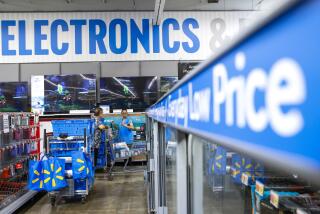Retail Sales in July Rise 0.4%; May Signal Slow Growth in Second Half
Following two months of declines, retail sales rose 0.4% in July, a scant increase that some economists said hobbles White House hopes for an economic surge in the second half of the year.
But others, including Commerce Secretary Malcolm Baldrige, found cause for optimism in July’s retail sales, which were buoyed by strong department store sales but dragged down by a decline in automobile purchases.
The Commerce Department said Tuesday that July retail sales rose to a seasonally adjusted $113.7 billion, the first increase since a 3.1% jump in April. If automobiles were excluded from the statistics, retail sales would have increased 0.7% in July.
Retail sales fell 0.4% in May and 1.4% in June, a figure that was revised downward from the previously reported 0.8% decline.
Consumers the Key
Baldrige acknowledged that July’s sales were 0.7 percentage point below the second-quarter average, “so third-quarter spending may not advance as much as the rapid 8.5% annual rate of the first two quarters.”
But, Baldrige added in a statement, “higher levels of consumer confidence and lower interest rates indicate consumers will be a mainstay of the expansion in the second half of the year.”
“Retail sales did rise, which was good news, but if there had been no downward revision in June, the July data would have actually shown a decline,” said economist Allen Sinai of Shearson Lehman Bros.
Sinai added: “The results must be disappointing to the Reagan Administration and to the Federal Reserve, because the retail sales report offers very little indication of a snapback in the second half.”
After a sluggish 1% annual rate of growth in the nation’s gross national product during the first six months of 1985, “the Fed is looking for 4.5% or more and the Administration needs 5% growth (from July to December) to reach 3% (growth) for the year,” he said. “You can’t get there from here, as they say in Maine.”
Consumer spending has slowed, he said, because disposable income when adjusted for inflation is growing at a much slower rate than in the first half of the year and consumer debt loads “are at a record high relative to income.”
In addition, “consumers are just not in the stores, especially not buying autos,” because they are traveling abroad or spending their money on summertime leisure pursuits, he said.
Sales Incentives Missing
Other economists were slightly more upbeat.
“I think there is some underlying reason for optimism in the report,” said Robert Wescott, a senior economist with Wharton Econometrics.
Car sales--a major reason that July’s retail sales increase was so modest--declined primarily because auto makers discontinued various sales incentives, Wescott said. Those incentives probably will be renewed when a strike by Teamsters-represented car haulers is settled, he said.
“This isn’t a huge growth in consumer spending,” he said, but it could signal a rebound in the second half of 1985 from the first six months of the year.
Robert T. Parry, chief economist at Security Pacific, said he had been expecting a 0.3% increase in July retail sales. But, given the substantial downward restatement of the June statistics, “we’re slightly disappointed by the numbers.”
July’s retail sales report “doesn’t give you a firm indication (of overall economic direction) whether you’re in the economy-is-getting-better school or whether you’re in the economy-is-going-in-the-tank school,” he said.
Parry expects economic growth to increase somewhat in the second half of the year, with GNP growing at 2.5% to 3% in the third quarter and 4% to 4.5% in the fourth quarter.
‘Uptick’ in 2nd Half Seen
“That to us is a significant contrast to the first half,” he said.
“The consumer isn’t about to crater,” said Duane Paul, senior economist with Bank of America. “Consumer spending is still moving along OK.”
B of A is predicting “a little bit of an uptick” in economic growth during the second half, with GNP advancing 3.2% to 3.4%, Paul said.
“I don’t think it’s the stuff of which booms are made,” he said. “We’re not exactly moving sideways, but we’re not exactly making a lot of headway, either.”
During July, sales of durable goods--items expected to last three or more years--rose 0.7%, compared to a 2.5% drop in June. Sales of non-durable goods rose 0.2% in July, compared to a 0.7% decline in June.
In the durable goods category, sales of automobiles slipped 0.5% in July, following a 1.9% plunge in June. Sales by building materials and hardware stores leaped 5%, while furniture store sales rose 0.9%.
In non-durable goods, department store sales increased 2.2% in July.
More to Read
Inside the business of entertainment
The Wide Shot brings you news, analysis and insights on everything from streaming wars to production — and what it all means for the future.
You may occasionally receive promotional content from the Los Angeles Times.










